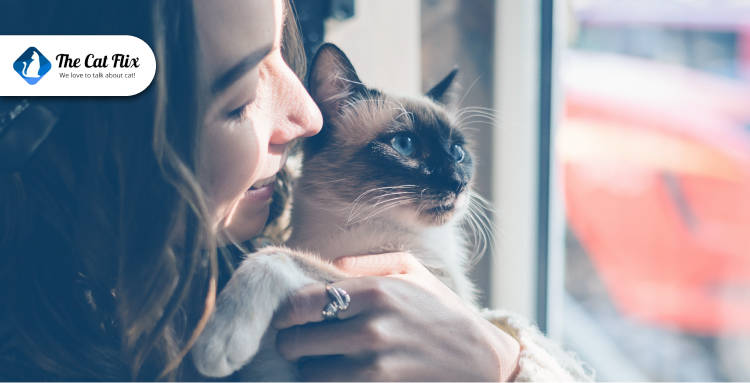You’ve brought a cat home today, or maybe you’re planning to welcome one soon. You have the essentials ready: a cozy bed, nutritious food, and a clean litter box. Is that enough? Not quite. These basics cover just 30% of what your new cat truly needs. The rest? It’s all about building trust, creating a connection, and forging a bond that makes your cat feel truly at home. Cats are not like your casual friends where a simple “hi” and “hello” can spark a connection. They thrive on meaningful relationships with their humans. Bonding with your cat takes effort. It’s not a day’s work; it’s a consistent endeavor.
But don’t worry, cats are incredibly perceptive and recognize emotional gestures. You just need a few tips from experts like Catflix and a little more consistency. So, how and where do you start?
5 Ways to Bond with Your Cat Quickly
Building a strong connection with your cat doesn’t have to be complicated. With a little patience and some simple strategies, you can create a bond that lasts a lifetime. Here are five easy ways to connect with your cat and make them feel loved and secure.
1. Hand Feed with Delicious Treat
Ever heard the saying “The way to a cat’s heart is through treats and play”? Well, it’s true. Tasty treats are a great starting point. Providing a bowl of food is fine for routine feeding, especially when you’re busy.
But for bonding, nothing beats hand-feeding. It’s a highly effective way to build trust and create positive associations. Imagine offering a small piece of cooked chicken or a commercial cat treat from your hand.
This simple act creates a direct connection and shows your cat that you’re the source of good things. They’ll start to associate your presence with positive experiences. This makes them more likely to approach you in the future.
2. Let Them Come to You
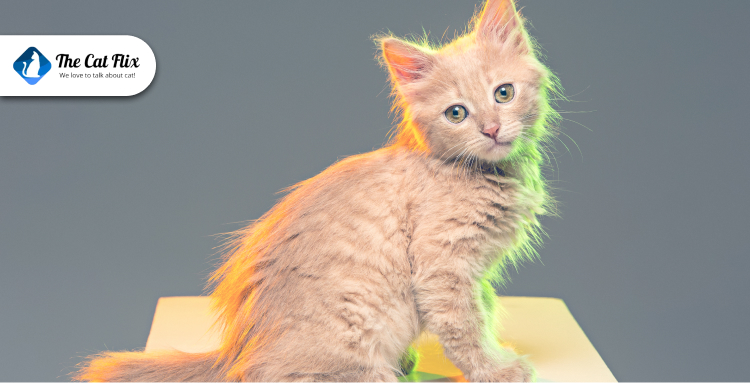
When you start hand-feeding, your cat will likely approach you cautiously at first—understandably, they’re focused on the delicious snack! But as they get used to this routine, they’ll become more comfortable being around you. This is a great first step towards building a lasting bond.
However, as eager as you might be to cuddle your new feline friend, it’s crucial to let them initiate interaction. Unexpected handling can be scary, especially for cats who have experienced trauma or are nervous around strangers.
Offer your hand and see if they approach. Even after your cat feels at home, respect their need for independence. If they show signs of wanting space (like tail twitching, hissing, or pulling away), give them some room. This builds trust and strengthens your bond in the long run.
3. Use Gentle Touch and Voice
Treat your cat like nurturing a flower. Even we humans don’t prefer harsh approaches or treatment. Why do cats then? Treat them with kindness and care. Use a soft touch, like gentle strokes along their back or under their chin.
Talking to your cat is also important. Use a soothing, friendly tone of voice as you go about your day. This helps them get used to your voice and feel more comfortable in your presence.
If your cat meows or chirps, talk back. They’re attempting to communicate with you, and engaging in these “conversations” can strengthen your connection. Experts believe that cats meow more around humans than in the wild. They say it’s a behavior they’ve adapted to get our attention. (Also read: Why Does My Cat Sound Like a Pigeon)
4. Engage with Interactive Play
Regular playtime is essential for bonding with your cat. Interactive play, in particular, is incredibly effective. It allows you to engage with your cat directly and build a shared experience.
Choose toys that mimic hunting, like feather wands, fishing rod toys, or laser pointers. These toys tap into their natural instincts and provide mental and physical stimulation. Set aside 10–15 minutes twice a day for play. Rotate the toys regularly to keep things interesting.
When they “catch” their prey during play, reward them with praise or a small treat to reinforce the positive experience. Playtime not only strengthens your bond but also helps your cat release energy and stay mentally sharp.
5. Learn and Adopt Cat Language
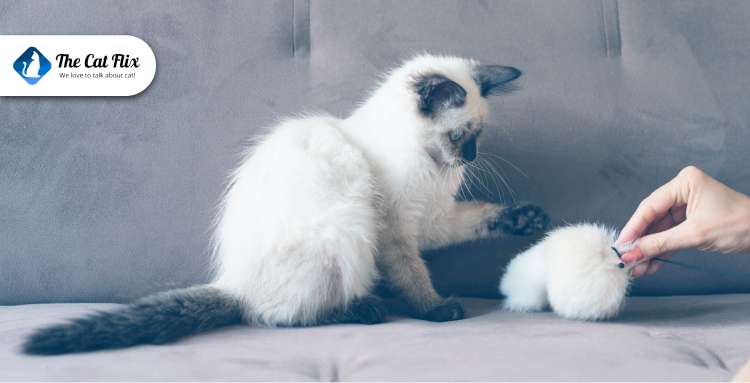
Building a strong bond is a two-way street. Just as your cat is learning about you and your habits, it’s important for you to learn about theirs. Cats communicate through a variety of signals, including meows, body language (like ear position and posture), and even tail movements.
Understanding these signals will help you respond appropriately to their needs and build a deeper connection. For example, a swishing tail can indicate agitation, while slow blinking can be a sign of affection.
Learning cat body language and vocalizations can significantly improve your communication. Remember, each cat is an individual with its own unique personality. Some breeds are naturally more social, while others are more independent.
When to Stop: Listening to What Your Cat is Saying
It’s crucial to respect your cat’s boundaries. Learn to recognize the signs that they don’t want to be touched. Some common signals include:
- Turning their head away from you or your hand
- Vigorously swinging their tail from side to side or hitting the floor with it
- Pushing your hand or face away with a paw
- Walking away
- Yowling in protest
- Hissing
- Growling
- Flicking, turning, or flattening their ears
- Skin rippling or twitching on their back
- Eyes wide open with large pupils
If your cat exhibits any of these behaviors, calmly stop petting them. Using a specific phrase, like “Okay, I understand,” can also be helpful. This reinforces that you’re listening to their cues and respecting their wishes.
How Do You Know Your Cat Has Bonded with You

So, you’ve been putting in the effort, following the tips, and showering your cat with love (on their terms, of course). But how do you know if your feline friend has truly bonded with you? Here are some telltale signs that your cat considers you a part of their inner circle:
- Head Bunting (aka “Head Bonks”): This is a classic sign of feline affection. When your cat gently bumps their head against you, they’re marking you – claiming you as their own.
- Licking or Grooming You: Cats groom each other as a sign of bonding and social connection. If they lick you, it’s a compliment. They include you in their group.
- Slow Blinking (aka “Kitty Kisses”): A slow blink is a cat’s way of saying “I trust you and feel comfortable around you.” If your cat slowly blinks at you, blink back. It shows mutual affection.
- Following You EVERYWHERE: If your cat shadows your every move, it’s a sign that they enjoy your company and feel secure around you. They might follow you even if you’re just going to the bathroom.
- Purring and Meowing: Purring when being petted or cuddled, is usually a sign of contentment and happiness. Meowing in response to your voice – trying to communicate with you.
- Going Belly Up (Not Always an Invitation for Rubs): Exposing the belly is often a sign of trust and vulnerability. But if they start to grab your hand with their paws or try to bite, it’s time to stop.
- Sticking Their Butt in Your Face: It might seem strange to us, but it’s a cat greeting. It’s their way of saying “hello” in cat language.
- Rubbing on Your Legs: When your cat rubs against your legs, they’re marking you with their scent, reinforcing their bond with you, and claiming you as part of their territory.
- Weaving Between Your Legs: This behavior is similar to rubbing, but it’s often more insistent. They’re not just marking you; they’re actively seeking your attention and affection.
- Hopping Onto Your Lap or Into Bed with You: If your cat chooses to nap on your lap or snuggle up with you in bed, it’s a clear sign that they feel safe and comfortable in your presence. They’re seeking warmth, comfort, and companionship.
- Sleeping Near You: Even if they don’t sleep directly on you, choosing to sleep in the same room or nearby is a sign that they feel secure and comfortable in your presence.
- Kneading You (Even if It Hurts!): When adult cats knead you, it’s a sign of comfort, contentment, and affection. While it can sometimes be a bit painful, try to tolerate it as a sign of their love. Use a blanket for protection.
- Bringing You Their Cat Toys (Or Their “Kill”): This is a very special sign of affection. When your cat brings you a toy or a “prize” (like a captured bug or toy mouse), they’re offering you a gift. They’re sharing their “hunting success” with you, considering you part of their family.
More for you: Why does my cat bring me toys?
What are Some Dos and Don’ts When It Comes to Strengthen Relationship with Your Cat
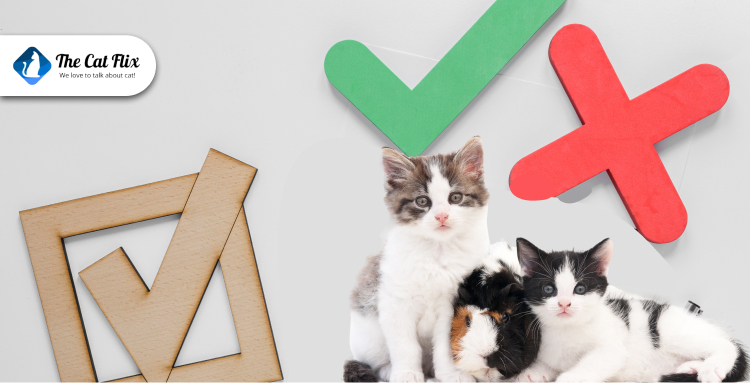
To make those five tips even more effective, here are some important dos and don’ts to keep in mind.
Dos:
-
Create a Safe Environment: Give your cat places to hide and high perches. A quiet, secure space where they can relax and feel protected.
-
Establish a Routine: Feed, play, and interact with your cat at the same times each day.
-
Give Clicker Training: Clicker training is effective. It uses positive reinforcement. It helps with bonding and training.
-
Be Patient: Bonding takes time. Don’t rush it. Let your cat set the pace. Showing patience and understanding will help create a lasting relationship.
-
Use Stress Diffuser: Diffusers release calming pheromones. They can reduce anxiety, and create a more relaxed environment. Try FELIWAY Classic Cat Diffuser.
Don’t:
-
Engage in Forceful Interaction: Never force your cat to interact with you. Forcing contact can damage their trust in you.
-
Create Loud Noises: Cats are sensitive to loud or sudden noises. Avoid shouting, slamming doors, or playing loud music.
-
Use Your Hands as Toys: Using your hands to play can encourage biting or scratching behavior. Stick to using proper cat toys.
-
Make Sudden Movements: Sudden movements can startle your cat. It makes them wary of you. Approach your cat slowly and gently.
-
Neglect Socialization: Expose kittens to different sights, sounds, and people. This helps them become well-adjusted adults.
-
Overwhelm Them: Too much attention, noise, or activity can overwhelm your cat. Give them space and time to recharge when they need it.
-
Use Punishment as a Solution: Punishment doesn’t work with cats. It damages trust. Use positive reinforcement instead.
Frequently Asked Questions
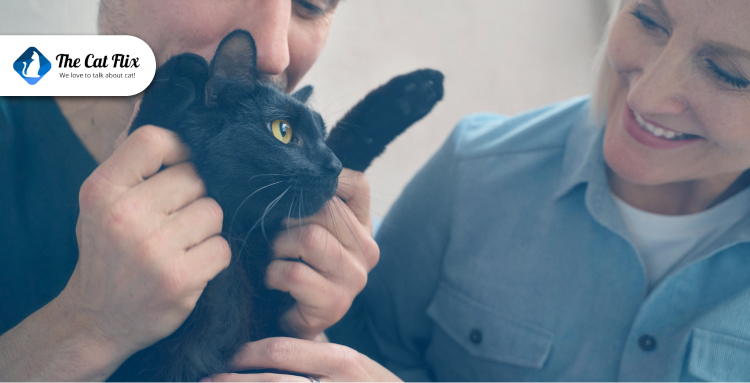
How long does it take to bond with a new cat?
It depends on the cat entirely. It typically takes 2–3 weeks, but some cats, especially rescues, may take several months.
Does it take less time to bond with a kitten than an adult one?
Kittens often bond faster as they are more adaptable. But adult cats form deeper and more meaningful bonds once trust is established.
Do cats choose whom to bond with?
Yes. Cats often choose one person they prefer. In multi-human households, they favor one person based on comfort, interaction style, and trust.
Could I be accidentally making my cat like me less?
Yes, it’s possible. Your petting style might not be what your cat prefers. Experiment with gentler, firmer strokes or try mimicking a mother cat’s grooming style like massaging their head and shoulders.
What kind of relationship does the cat think of it as when it bonds with humans?
Cats view their bonded humans as a sort of “super-mama cat.” They use the same body language they used with their mothers as kittens.
Final Thoughts on Bonding with Cats
Building a strong bond with your cat takes time, patience, and understanding, but the rewards are immeasurable. Respecting their boundaries, learning their language, and providing a safe and enriching environment – create a deep and lasting connection. Remember, every small step strengthens your connection, making life richer for both you and your furry companion.
Now, we want to hear from you! What bonding tips have worked best for you and your furry friend? Share your stories and experiences in the comments below, and don’t forget to share this article with other cat lovers.

